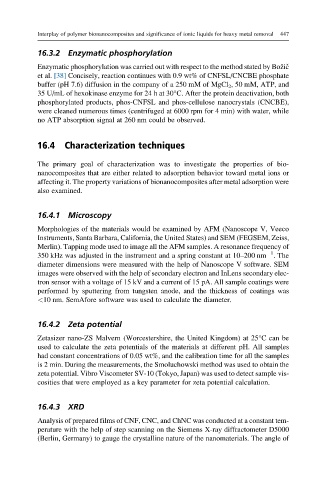Page 494 - Polymer-based Nanocomposites for Energy and Environmental Applications
P. 494
Interplay of polymer bionanocomposites and significance of ionic liquids for heavy metal removal 447
16.3.2 Enzymatic phosphorylation
Enzymatic phosphorylation was carried out with respect to the method stated by Boz ˇic ˇ
et al. [38] Concisely, reaction continues with 0.9 wt% of CNFSL/CNCBE phosphate
buffer (pH 7.6) diffusion in the company of a 250 mM of MgCl 2 , 50 mM, ATP, and
35 U/mL of hexokinase enzyme for 24 h at 30°C. After the protein deactivation, both
phosphorylated products, phos-CNFSL and phos-cellulose nanocrystals (CNCBE),
were cleaned numerous times (centrifuged at 6000 rpm for 4 min) with water, while
no ATP absorption signal at 260 nm could be observed.
16.4 Characterization techniques
The primary goal of characterization was to investigate the properties of bio-
nanocomposites that are either related to adsorption behavior toward metal ions or
affecting it. The property variations of bionanocomposites after metal adsorption were
also examined.
16.4.1 Microscopy
Morphologies of the materials would be examined by AFM (Nanoscope V, Veeco
Instruments, Santa Barbara, California, the United States) and SEM (FEGSEM, Zeiss,
Merlin). Tapping mode used to image all the AFM samples. A resonance frequency of
1
350 kHz was adjusted in the instrument and a spring constant at 10–200 nm .The
diameter dimensions were measured with the help of Nanoscope V software. SEM
images were observed with the help of secondary electron and InLens secondary elec-
tron sensor with a voltage of 15 kV and a current of 15 pA. All sample coatings were
performed by sputtering from tungsten anode, and the thickness of coatings was
<10 nm. SemAfore software was used to calculate the diameter.
16.4.2 Zeta potential
Zetasizer nano-ZS Malvern (Worcestershire, the United Kingdom) at 25°C can be
used to calculate the zeta potentials of the materials at different pH. All samples
had constant concentrations of 0.05 wt%, and the calibration time for all the samples
is 2 min. During the measurements, the Smoluchowski method was used to obtain the
zeta potential. Vibro Viscometer SV-10 (Tokyo, Japan) was used to detect sample vis-
cosities that were employed as a key parameter for zeta potential calculation.
16.4.3 XRD
Analysis of prepared films of CNF, CNC, and ChNC was conducted at a constant tem-
perature with the help of step scanning on the Siemens X-ray diffractometer D5000
(Berlin, Germany) to gauge the crystalline nature of the nanomaterials. The angle of

